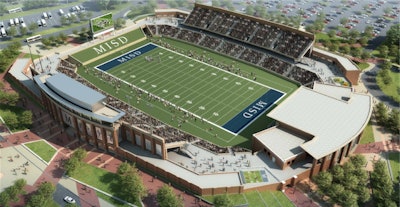
Editor’s note: In May 2016, voters approved a bond package that allowed the McKinney (Texas) Independent School District to construct a multi-million-dollar high school football stadium. Construction on the project began in December 2016, and is expected to be complete in late 2017. Valerie Little, Associate AD for McKinney ISD, will be providing an exclusive inside look at coordinating the effort.
There are several foundational philosophies we as a district have relied upon to overcome some of the early challenges in this project. Now, despite all the negative media attention the McKinney (Texas) ISD has gotten for our new stadium project, the excitement in our community is palpable.
Embrace the Community
The most important facet of building a stadium is to ensure buy-in from all stakeholders. Your community must be convinced the stadium is what’s best for their student population so they will defend it throughout the process. The first person you need buy-in from is your superintendent. Their overall vision needs to align with yours on this project so it will end up being enjoyable and rewarding. Then, spend time presenting to the community.
We met with multiple community groups individually to educate them and garner their support. Don’t simply present to a group when you need their support, make it a common gesture. We present to the Rotary at least once a year. We also present to McKinney Can (a parent group) annually, as well as our coaching staff and the individual booster clubs of each sport at each school. Make it a habit to attend their meetings. That way, they’ll be more willing to listen to your presentation, as they know you support their program.
Our presentation for the bond started with showing the community our current needs – including graphic photos of the stadium at its worst. For example, we shared pictures taken during football games depicting cars parked on sidewalks due to lack of appropriate parking space. We also showed what neighboring districts are providing for their student-athletes and community compared to what we had to offer.
Get the Word Out
A turning point for our project was when an interview with athletic director Shawn Pratt was published in the Dallas Morning News. When questioned about the budget for the new stadium, Pratt said, “I’ve seen what high school athletics can do. They teach kids lessons they can’t necessarily learn in English or Math. Our curriculum is first and foremost, but my son’s experiences in football were no less important than what he experienced in his academic classes. Football taught him a lot of intangibles and life lessons he can’t learn otherwise. There will be more fine arts students performing there than athletes competing. It’s an overall educational experience and tool, and people don’t realize that. People think it’s all about winning a football game and there’s so much more to it.”
Pratt went on to say, “We want first-class facilities for our kids, and we’re not apologizing for that.” This article reminded our community of the value of athletics for McKinney ISD, making it easier to obtain buy-in from those who no longer looked at the bond as just a stadium bond.
Solicit Input from Stakeholders
During the design phase, we went to our fine arts and band directors to ask for their wish list of what they’d like to see in the stadium. We pointed out features that we planned to include to enhance their experience such as the Fine Arts Plaza, complete with restrooms and ice machine. Our strategy here was to let these groups know they were as important as the football team when it came to the stadium fitting their needs. We wanted to make them feel good about the relationship they have with athletics and let them know their input is valued. Our next groups to focus on were coaches, athletic trainers and team doctors. They assisted us in designing the locker rooms, offices and training areas. Speaking with these groups about basic needs helped to garner their support for the bond.
We then brought in our technology department to get their opinion on the number of Wi-Fi access points, basic technology needs for media, stadium TV placement and most importantly, to discuss the video board. Our broadcast journalism groups have become an integral part of our game nights, since their students live stream our games, so we solicited their input in designing their ideal broadcast room. Throughout the design phase we also kept in communication with safety & security, grounds & maintenance, food service, custodial services, ticketing services and the media. Soliciting ideas from these groups allowed us to design a stadium that meets everyone’s needs. It also provides each group with a feeling of ownership and a sense of pride in the project.
Tie All Groups into the Stadium’s Branding
We are currently collecting a wide range of pictures of football teams, bands, cheerleaders, drill teams and anything else pertaining to McKinney ISD from the past up to the present. We will find a way to tie these memorabilia into the décor of the stadium to help tell the story of McKinney ISD and all of the success we have experienced in our history. We are also researching engraved brick programs for the stadium. This will be one more way to ensure all stakeholders have a chance make their mark on the project.  Image courtesy Valerie Little.
Image courtesy Valerie Little.
Educate as Many People as Possible
Start with educating the bond committee. Our district was well-prepared each time they were in front of the committee, and our superintendent and cabinet always presented a unified vision and plan that instilled confidence in our committee and gave us credibility. We then presented to any group who wanted any information about the bond -- booster clubs, campus coaches’ meetings, youth sports organizations, Rotary clubs, Lions clubs.
When we were presenting, the key was to be completely transparent and answer all questions openly and honestly for the public to see we were on the same side and all had the same goal – to improve our district with the bond. Making ourselves available to the public helped the school district to build trust within our community.
Coach Pratt had several one-on-one meetings in his office with taxpayers who did not understand the bond process. He would educate them on the bond process and the overall bond plan and how it would benefit all MISD students. Without fail, they would leave as a friend of the program – and crucially, a “yes” vote.
Create a Hospitable Atmosphere in the Press Box
Last year we employed our first sports information director, who has generated a lot of great information to which the media has provided positive feedback. Our SID will send stats or interesting facts during games for us to push out on our Stadium app. This practice carries over to all of our sports– basketball, soccer, baseball and softball. We try to take care of our local reporters as much as possible in regards to comfort and a place to watch the game. We ensure that our coaches give them their time after each game, regardless of outcome. In my opinion, these small perks have helped to provide us a good reputation amongst the media ranks.
Meet the Critics Head-On
As you can imagine, when building a new facility, everyone has his or her own idea of how it should be done. Due to the fact that we already have a good track stadium, coupled with the cost of annual maintenance and upkeep, we decided against including a track in our new stadium. This brought out quite a few critics. Not only did we have to explain it to our own track coaches, but we also have a large Special Olympics program that was looking forward to a track meet in the new facility. Once we educated them on the increased costs and the proposed plan for upgrades to the track experience at the existing facility, they too were back on board. Several community naysayers had an issue with the total cost of our stadium. Instead of avoiding these people, we had them on our bond committee so we could keep them in the loop. We were eventually able to change their minds and even gain their support.
When building a stadium, you need to build the foundation in your community first. You need their support behind the project – get them to buy in and be your voice to the naysayers. Relationship building is not only important within your community; it is important with your media outlets as well. Build healthy relationships with your support groups, local media and community in general before you need to call on them for support. Openness, honesty and transparency will go a long way towards creating stakeholder buy-in. Getting everyone on board and feeling as if they are an important part of the project will benefit you in the long run.




































